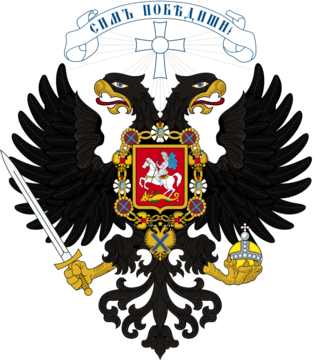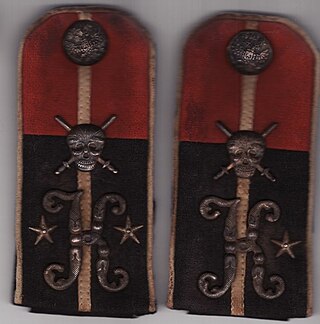See also
| Senior administration | |||||||||||||||||||||||||||||||||||
|---|---|---|---|---|---|---|---|---|---|---|---|---|---|---|---|---|---|---|---|---|---|---|---|---|---|---|---|---|---|---|---|---|---|---|---|
| Fronts |
| ||||||||||||||||||||||||||||||||||
| Field armies |
| ||||||||||||||||||||||||||||||||||
| Army corps |
| ||||||||||||||||||||||||||||||||||
Russian army formations in World War I include:

Mechanized infantry are infantry units equipped with armored personnel carriers (APCs) or infantry fighting vehicles (IFVs) for transport and combat.

The Workers' and Peasants' Red Army, often shortened to the Red Army, was the army and air force of the Russian Soviet Republic and, from 1922, the Soviet Union. The army was established in January 1918 by Leon Trotsky to oppose the military forces of the new nation's adversaries during the Russian Civil War, especially the various groups collectively known as the White Army. In February 1946, the Red Army was renamed the "Soviet Army" - which in turn became the Russian Army on 7 May 1992, following the dissolution of the Soviet Union.
A division is a large military unit or formation, usually consisting of between 10,000 and 25,000 soldiers. In most armies, a division is composed of several regiments or brigades; in turn, several divisions typically make up a corps.

The Russian Liberation Army was a collaborationist formation, primarily composed of Russians, that fought under German command during World War II. The army was led by Andrey Vlasov, a Red Army general who had defected, and members of the army are often referred to as Vlasovtsy (Власовцы). In 1944, it became known as the Armed Forces of the Committee for the Liberation of the Peoples of Russia.
Guards or Guards units were elite military units of Imperial Russia prior to 1917–18. The designation of Guards was subsequently adopted as a distinction for various units and formations of the Soviet Union and the modern Russian Federation. The tradition goes back to a chieftain's druzhina of medieval Kievan Rus' and the streletskoye voysko, the Muscovite harquebusiers formed by Ivan the Terrible by 1550. The exact meaning of the term "Guards" varied over time.

The Russian Ground Forces, also known as the Russian Army, are the land forces of the Russian Armed Forces.

Line infantry was the type of infantry that formed the bulk of most European land armies from the mid-17th century to the mid-19th century. Maurice of Nassau and Gustavus Adolphus are generally regarded as its pioneers, while Turenne and Montecuccoli are closely associated with the post-1648 development of linear infantry tactics. For both battle and parade drill, it consisted of two to four ranks of foot soldiers drawn up side by side in rigid alignment, and thereby maximizing the effect of their firepower. By extension, the term came to be applied to the regular regiments "of the line" as opposed to light infantry, skirmishers, militia, support personnel, plus some other special categories of infantry not focused on heavy front line combat.

Podpolkovnik is a military rank in Slavic and nearby countries which corresponds to the lieutenant colonel in the English-speaking states and military.

The White Army or White Guard, also referred to as the Whites or White Guardsmen, was a common collective name for the armed formations of the White movement and anti-Bolshevik governments during the Russian Civil War. They fought against the Red Army of Soviet Russia.
The Caucasus Front was a major formation of the army of the Russian Republic during the First World War. It was established in April 1917 by reorganization of the Russian Caucasus Army and formally ceased to exist in March 1918.

Military organization (AE) or military organisation (BE) is the structuring of the armed forces of a state so as to offer such military capability as a national defense policy may require. Formal military organization tends to use hierarchical forms.

The 18th Machine Gun Artillery Division is a division of the Russian Ground Forces stationed in Sakhalin Oblast with administration over the Kuril Islands.
The Volkhov Front was a major formation of the Red Army during the first period of the Second World War. It was formed as an expediency of an early attempt to halt the advance of the Wehrmacht Army Group North in its offensive thrust towards Leningrad. Initially the front operated to the south of Leningrad, with its flank on Lake Ladoga.

The 44th Kievskaya of the Red Banner Rifle Division of Nikolay Shchors, or 44th Kievskaya for short, was an elite military formation of the Soviet Union. Created during the beginnings of the Russian Civil War. It was destroyed during the Winter War, after being ordered to help the 163rd Infantry Division break a Finnish siege on the Raate road as part of the Special Rifle Corps 9th Army, together with the 54th Rifle Division. Afterwards it was levied and dissolved multiple times throughout the 40s and 50s until its final dissolution in 1959.

The Volunteer Army was a White Army active in South Russia during the Russian Civil War from 1917 to 1920. The Volunteer Army fought against Bolsheviks and the Makhnovists on the Southern Front and the Ukrainian War of Independence. On 8 January 1919, it was made part of the Armed Forces of South Russia, becoming the largest force of the White movement until it was merged with the Army of Wrangel in March 1920.

Red Guards were paramilitary volunteer formations consisting mainly of factory workers, peasants, cossacks and partially of soldiers and sailors for "protection of the soviet power". Red Guards were a transitional military force of the collapsing Imperial Russian Army and the base formations of Bolsheviks during the October Revolution and the first months of the Russian Civil War. Most of them were formed in the time frame of the Russian Revolution of 1917, and some of the units were reorganized into the Red Army during 1918. The Red Guards formations were organized across most of the former Russian Empire, including territories outside the contemporary Russian Federation such as Finland, Poland, Estonia, Ukraine, and others. They were not centralized and were formed by decision of a local political party and local soviet members. By fighting to protect and extend the power of the Soviets, they aided the creation of a new state that would give "all power to the soviets": the Soviet Union.
The Reserve of the Supreme High Command (Russian: Резерв Верховного Главнокомандования; also known as the Stavka Reserve or RVGK or RGK comprises reserve military formations and units; the Stavka Reserve acted as the principal military reserve of the Soviet Red Army during World War II, and the RVGK now operates as part of the Russian Armed Forces under the control of the Supreme Commander-in-Chief of the Russian Armed Forces — the President of the Russian Federation.
The 56th Rifle Division was an infantry division of the Red Army and later the Soviet Army of the Soviet Union, formed three times.

The 172nd Rifle Division was an infantry division of the Red Army during World War II, formed thrice.

Military ranks and insignia of the White Movement (1918-1922) were based on the former Ranks and insignia of the Imperial Russian Armed Forces. However, there were new features and modifications compared to the old system: